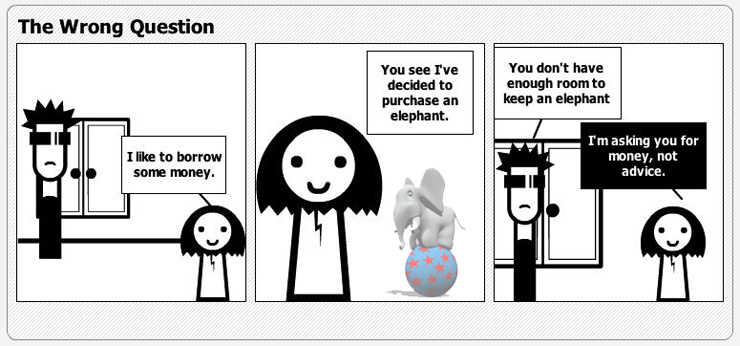Reader: Coleman Barks
Tag Archives: sufism
Teaching Cartoon: Wrong Question
Versions of this teaching story are found in the folklore of the Mid-east and North Africa. This version refashions source material discovered in Matthew Helmke’s Humor and Moroccan Culture.
Happy new year to all in this year of the Rat.
Online cartoon generation courtesy of stripgenerator v1.0.3.
DHIKR
Shaikh Abul Janaab Najmuddin al-Kubra (may Allah favor him,) in his book Fawatih ul-Jamaal, wrote “Dhikr is flowing in the body of creatures by the necessity of their breath, because through their breathing, the letter ‘Ha’ of the Divine Name ‘Allah,’ is the very sound made with every exhalation and inhalation and it is a sign of the Unseen Essence serving to emphasize the Uniqueness of God. Therefore it is necessary to be present with that breathing, in order to realize the Essence of the Creator. God’s name ‘Allah’ encompasses God’s ninety-nine Names and Attributes and consists of four letters, ‘Alif,’ ‘Lam,’ ‘Lam’ and ‘Hah’ (ALLAH). The absolute unseen Essence of God, Glorious and Exalted, is expressed by the letter ‘Hah’ which represents the Absolute Unseen which is the same letter ‘Hah’ which is used in the name ‘Allah’ which encompasses the ninety-nine Names and Attributes. That name, as we said, consists of four letters: the letter ‘Ha’ which is ‘Ha’ and ‘Alif’, and it represents the Absolute Unseen of Allah. The first ‘Lam’ is for the sake of identification and the second ‘Lam’ is for the sake of emphasis.
Filed under sufism
I’M CONCEALED
I’m so close to you that I’m far apart,
So completely merged that I’m separate,
So vastly exposed that I’m concealed,
So whole and sound that I’ll never be healed.
#1121, from Rumi’s Kolliyaat-e Shams-e Tabrizi
Edited by Badiozzaman Forouzanfar (Tehran, Amir Kabir, 1988).
From translations of Rumi by Zara Houshmand
Filed under sufism
TO HIM IT’S ALL ONE
|
The friend to whom flower and thorn are one, In whose faith, Koran and Cross are the same — Why should we worry? To him it’s all one: The swiftest horse or a donkey that’s lame. #454: From Rumi’s Kolliyaat-e Shams-e Tabrizi Translated by Zara Houshmand |
Filed under sufism
Teaching Cartoon: Company Time
Teaching Cartoons is a concept for a workshop. It’s easy to describe. Participants learn how teaching stories used in spiritual traditions, such as Sufism and Buddhism, may be translated into cartoon form. Then, after being appraised of some of the constituent tropes, operations and procedures utilized in these forms of teaching, they are also revealed to be commonly available in many kinds of contemporary cartoons.
We’ll get into this as, every month, new cartoons are posted. One of the convenient capabilities of the internet is the addition of cartoon-building web sites that make the creation of cartoons simple and ‘open source’.
RENAMING & PREPARING TO PREPARE
I added the emphasis in the following clipping. …food for reflection. I’ll follow up with a teaching cartoon shortly.
Excerpt. The Wisdom of Sufic Humor, Idries Shah; originally published in Human Nature; April 1978
Sufis see many traditional prayers and processes, today more familiar than ever to most Westerners, as relics of specific, scripted, and measured formulas designed in the past to help people in the past to attain knowledge of the absolute and of their real selves. The existence of repetitious and automatistic chants, phrases, and dances was often pointed out by the Sufis in the past as being the ignorant perpetuation of formerly effective instruments. Technical knowledge, instead of being applied, tends to become sacroscant and used for a low level of autohypnosis and even ideological and community indoctrination: the very reverse of the original Sufic intention.
Sufis maintain that anyone who says that by prayer and exercise he or she will storm the gates of heaven is someone not prepared to prepare. Such an assault essentially tries to abolish the problem of intricacy by denying that it exists: It is like solving the problem of a missing button by sewing up the buttonhole.
Sufis do not stress the primacy of teaching, exercises, or dressing people in odd clothes. For the Sufis, humanity is already full of misconceptions and unsuitable, counterproductive habit patterns that must be attended to before there is a fair chance of progress toward a more objective understanding. “You must empty out the dirty water before you fill the pitcher with clean” is one of the ways they put it.
Since most people’s spiritual life is really their emotional-psychological-social life renamed, Sufis start with this aspect when trying to clear up the confusion that is the usual condition of most people’s minds.
Their natural allies are modern psychology and sociology, which have pointed out something similar. In the past, Sufis lacked the support of such parallel research and therefore often had to teach in secret. Hysteria was often considered sacred; monomaniacs were sometimes regarded as saints. Only recently have most societies accepted the idea that greed, say, is sure to be greed, even if it is greed for enlightenment; or that emotion, no matter what kind it is, may be harmful.
Sufis traditionally address themselves to the actual social-psychological situation, while those who do not understand the priorities clamor for “spiritual” teachings. Such teachings are useless if floated on top of the psychology of the ordinary individual, however useful that psychology is for limited purposes.
Sanctimoniousness, vanity, and self-will must be set aside in Sufi studies. For this reason, a person’s illusions of self-esteem may have to be deflated. Many people cannot endure such an approach, and the result is that some leave and set up synthetic Sufi systems, some turn against the Sufis, and some become servile because they mistake humility for self-abasement. A few, on the other hand, understand what is going on and profit from it. The Sufi has no responsibility to work with people who reject his attitude. In fact, he is incompetent to do so. This rejection is often unconscious, since many would-be learners in reality are seeking social stabilization, comfort, or attention, not knowledge and understanding.
Filed under adult learning, sufism
IN THE NOWHERE THAT YOU CAME FROM
If you could give up tricks and cleverness, this would be the cleverest trick!
Rumi was one of the great lanterns of experiential spirituality and Sufism. Today, not only is Rumi the most read poet in the world, his work imbues many spiritual ‘schools’ with important psychological, esoteric and yogic principles and methods.
Who was Rumi? What is the Mevlevi Order? For one thing, it’s not one order today. Here are portals to sites in Turkey, Mevlana.com, and the United States, The Threshold Society. Many fine web sites are maintained on behalf of Rumi’s continuing influence, ranging from examples of orthodox and heterodox views. Many familiar with his poetry will know the versions of Coleman Barks and John Moyne. There are a many other sources of his poetry on the web, including Khamush.com
Divan e-Shamsa & Mathnavi (Masnavi i Ma’navi ) @rumionfire Blissbat Zara Houshmand. Oneworld-publications maintains a recommended listing of links, as does Khamush. Stan Tenen’s schematic perspective on the Sema, the Mevlevi ritual dance is interesting. Finally, Omphaloskepsis offers many downloads of important Sufi literature.
Filed under sufism




